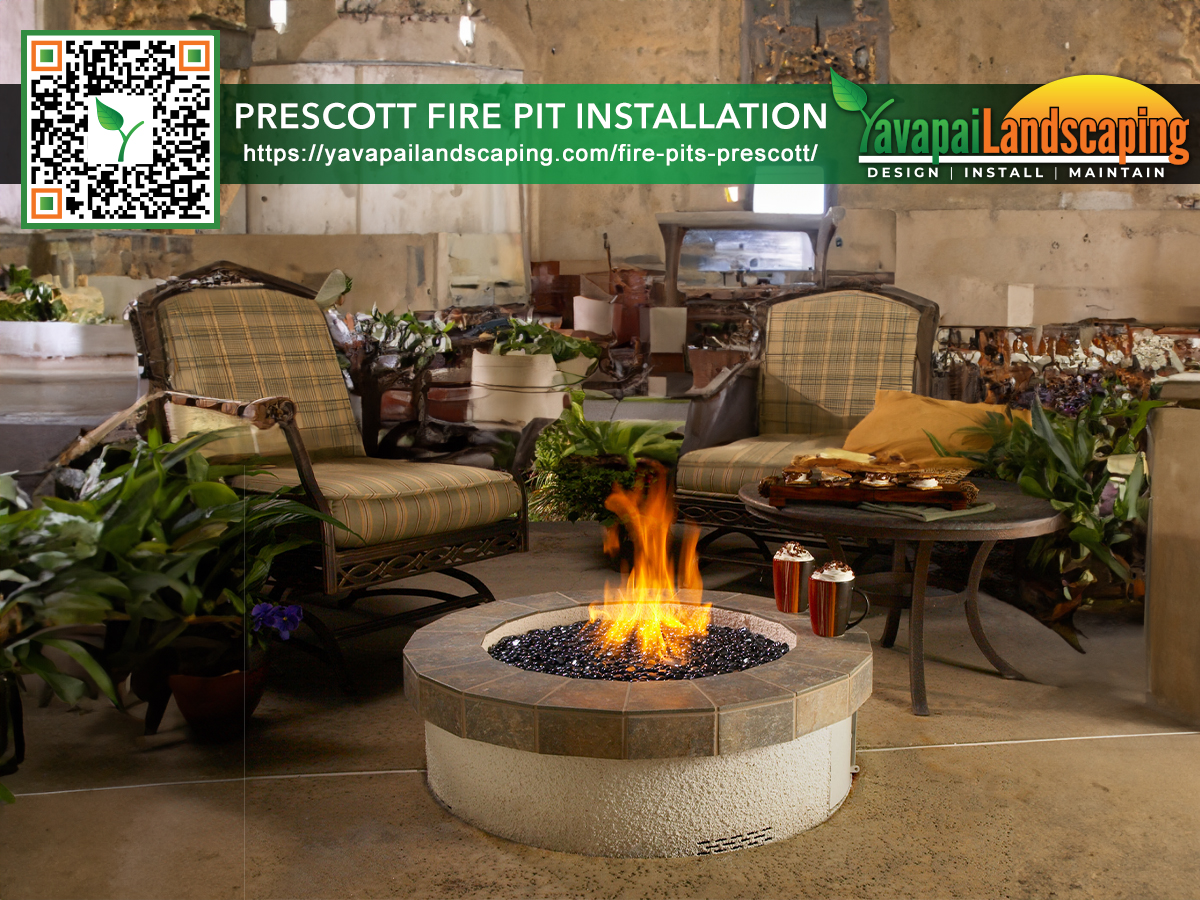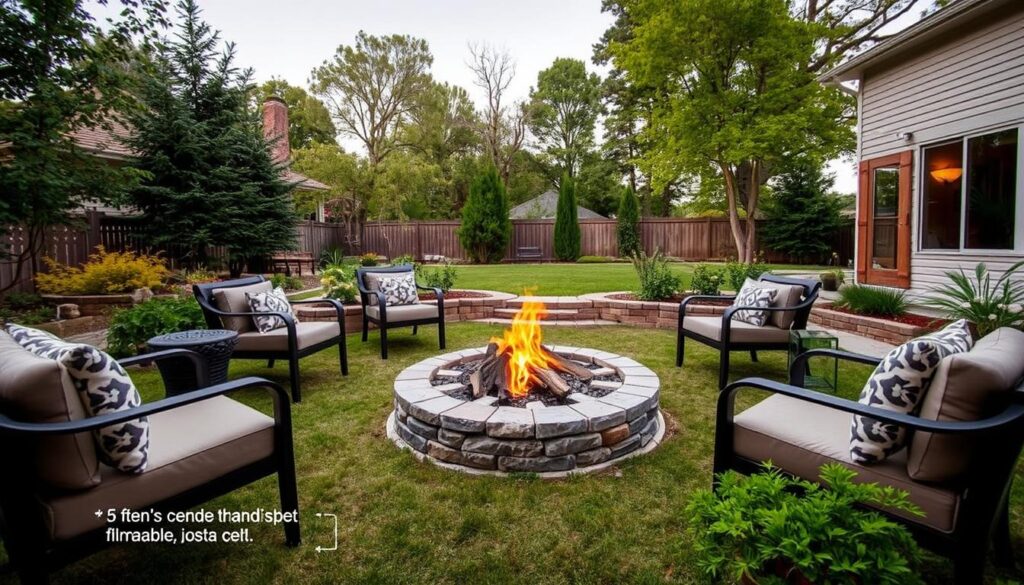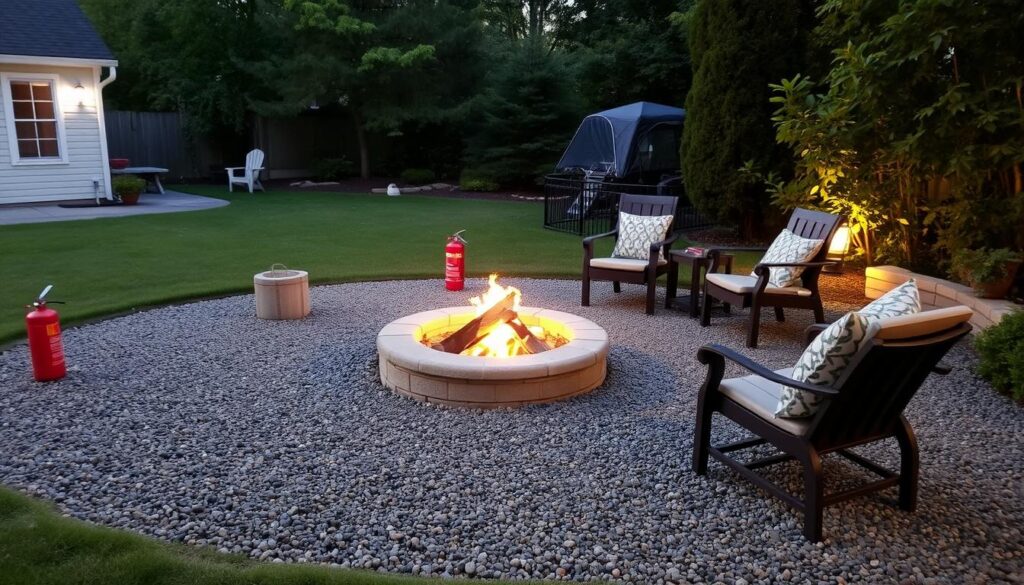
Building a backyard fire pit is a fun DIY project. It brings warmth and charm to your outdoor area. But, it’s important to focus on outdoor fire safety. A well-planned installation prevents accidents and makes a cozy spot for family and friends.
DIY project safety is crucial when making a fire pit. By following the right steps, you can avoid mistakes that could cause injuries or damage. Let’s look at important tips to make your fire pit safe and fun.
A safe fire pit begins with careful planning and execution. You’ll create a beautiful outdoor feature by understanding safety needs and best practices. It will bring joy for many years.
Key Takeaways
- Prioritize outdoor fire safety in your DIY fire pit project
- Follow proper guidelines to prevent accidents and injuries
- Plan carefully before starting your backyard fire pit installation
- Understand local safety regulations and obtain necessary permits
- Choose fire-resistant materials for a secure outdoor fire feature
- Regular maintenance is crucial for long-term fire pit safety
Understanding Fire Pit Safety Regulations and Permits

Before you start building your dream fire pit, it’s crucial to understand the legal aspects. Fire pit regulations vary by location and can impact your project significantly.
Local Fire Codes and Zoning Laws
Each area has specific zoning laws governing outdoor structures. These laws dictate where to place your fire pit and how far it must be from buildings. Check with your local zoning office to learn about restrictions in your neighborhood.
Obtaining Necessary Permits
Many areas require safety permits for fire pit installations. These permits ensure your fire pit meets local standards. Contact your city hall or fire department to determine what permits you need. The process might involve submitting plans and getting inspections.
Insurance Considerations for DIY Fire Pits
Your homeowner’s insurance policy may be affected by a DIY fire pit. Some policies might not cover accidents related to non-professionally installed fire features. It’s wise to inform your insurance provider about your plans. They can advise you on any policy changes or additional coverage you might need.
- Research local fire pit regulations
- Understand zoning laws in your area
- Obtain all necessary safety permits
- Check with your homeowner’s insurance provider
By addressing these legal and safety aspects early, you’ll avoid potential issues down the road. This preparation ensures your fire pit project stays within the bounds of local laws and insurance requirements. Give yourself the gift of knowledge – read this remarkable piece.
Choosing the Right Location for Your Fire Pit

Finding the perfect spot for your fire pit is key for safety and fun. You need to think about a few things to ensure your outdoor area is safe and comfy.
First, keep your fire pit away from your house and other buildings. Aim for at least 10 feet, but local rules might say more. This space helps avoid fires and keeps smoke out of your home.
Then, think about what’s around your fire pit. Don’t put it near trees, bushes, or things that can catch fire. These can get burned by sparks or heat. Pick a spot that’s open and has no nearby flammable stuff.
Also, check how high things are above your fire pit. Ensure there are no low branches, power lines, or other things that could get in the way. Having at least 21 feet of clear space above is best for safety.
- Level ground: Choose a flat surface to prevent tipping or rolling logs
- Wind direction: Position the fire pit to minimize smoke blowing towards seating areas
- Accessibility: Ensure easy access to fuel and maintenance
Thinking about these things when you place your fire pit’ll make a safe and welcoming outdoor area. Good planning helps avoid accidents and lets you enjoy your fire pit for a long time.
Essential Tools and Materials for Safe Fire Pit Installation
Building a fire pit needs careful planning and the right tools. Let’s look at the must-have items for a safe and successful installation.
Safety Equipment Checklist
Before starting, gather essential fire pit safety gear:
- Safety goggles
- Work gloves
- Dust mask
- Steel-toed boots
- First aid kit
Recommended Fire-Resistant Materials
Choose fire-resistant materials for your pit’s structure:
- Fire bricks
- Concrete blocks
- Lava rocks
- Fire-rated concrete
Tools for Proper Construction
Gather these tools for a smooth installation process:
- Shovel and rake
- Level
- Tape measure
- Trowel
- Rubber mallet
- Wheelbarrow
You’re set to build a safe and durable fire pit with the right safety gear, materials, and tools. Always follow local rules and the maker’s instructions for each item.
DIY Fire Pit Installation Safety Tips

When you’re setting up a DIY fire pit, safety is key. Follow these tips to make sure your installation is safe and accident-free.
First, wear protective gear. Safety goggles, gloves, and sturdy boots will protect you from harm. Also, clear the area of anything that can catch fire before you start digging.
Be careful when digging to avoid hitting underground utilities. Call your local utility company to mark any lines before digging. This step can save you from expensive mistakes and dangerous situations.
- Keep a fire extinguisher nearby during installation
- Use fire-resistant materials for the pit structure
- Ensure proper ventilation to prevent gas buildup
- Install a spark screen to contain embers
When laying bricks or stones, use a level to keep things stable. An uneven fire pit is dangerous and might collapse. Use heat-resistant mortar between layers for extra strength and durability.
Make sure there’s enough space around the fire pit for safe movement. A 10-foot clear area in all directions is best. This space prevents burns and makes it easier to get help if needed.
Following these steps will give you a safe and fun outdoor space for years. Always put accident prevention first to make your DIY fire pit project successful.
Proper Fire Pit Construction Techniques
Building a safe and durable fire pit needs careful planning and execution. Let’s look at the key steps in fire pit construction. This ensures your outdoor spot is both functional and secure.
Excavation and Base Preparation
Begin by marking the fire pit area and using proper excavation techniques. Dig about 6 inches deep, removing grass and soil. Make a level surface and add a layer of gravel for drainage.
Building the Fire Pit Structure
Choose heat-resistant materials like fire bricks or concrete blocks for the walls. Depending on your design, arrange the first layer in a circle or square shape. Use masonry adhesive between layers for stability.
Build up the walls, checking for level and plumb as you go.
Installing Heat-Resistant Lining
Line the inside of your fire pit with fire-rated bricks or stones. This extra layer protects the outer structure from intense heat. Use refractory cement to secure the lining in place.
Leave small gaps between bricks for expansion during heating and cooling cycles.
Remember to follow local regulations and safety guidelines throughout the fire pit construction process. With careful attention to detail, you’ll create a safe and inviting outdoor feature for years of enjoyment.
Maintenance and Usage Guidelines for Fire Pit Safety
Keeping your fire pit in good shape is crucial for safe outdoor fun. Before you light it up, check for any damage. Look for cracks, loose stones, or other issues that could be a problem. Also, often clean out ash and debris to keep the air flowing well.
Remember some key safety tips when you’re ready to fire up the pit. Always have a fire extinguisher or a bucket of water nearby. Never leave the fire alone, and watch kids and pets closely. Use only dry, seasoned wood to cut down on smoke and sparks. And never use gasoline or other flammable liquids, as they can cause big fires.
It’s important to know how to put out a fire safely. If you can, let the fire burn down on its own. If not, use water to put it out and mix the ashes to ensure everything is extinguished. Once it’s cool, put the ashes in a metal container away from buildings. Keep firewood and other flammable stuff far from your fire pit to avoid accidents.
Taking care of your fire pit and following these safety tips will ensure everyone has a good time outside. Remember, regular maintenance and following safety rules can help avoid accidents and make your fire pit last longer.
Yavapai Landscaping Prescott offers complimentary estimates for Prescott and its nearby localities for landscaping and tree services, ranging from tree removal, trimming, stump grinding, land clearing, and storm cleanup to emergency tree care.
